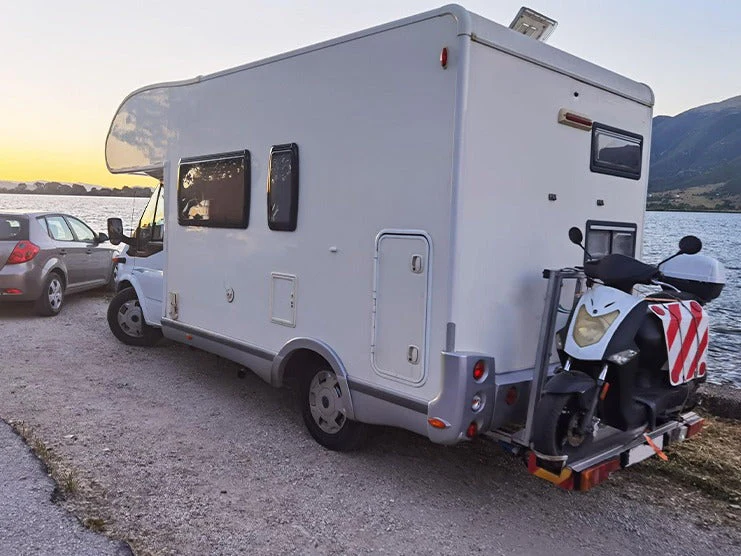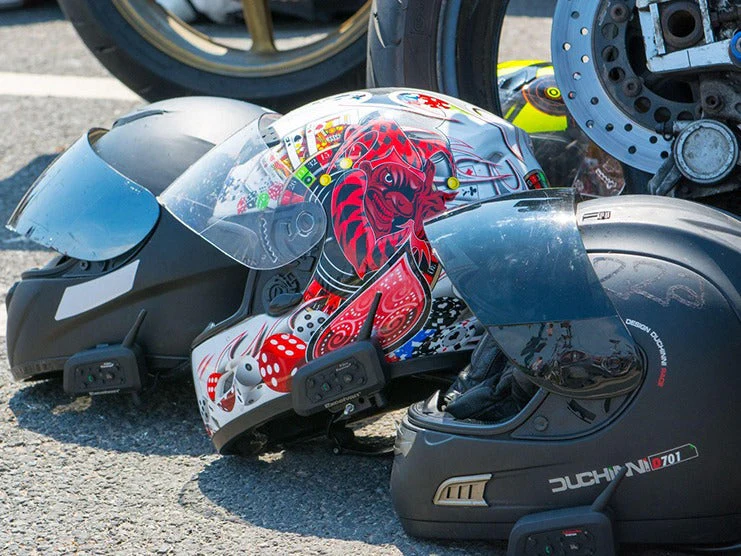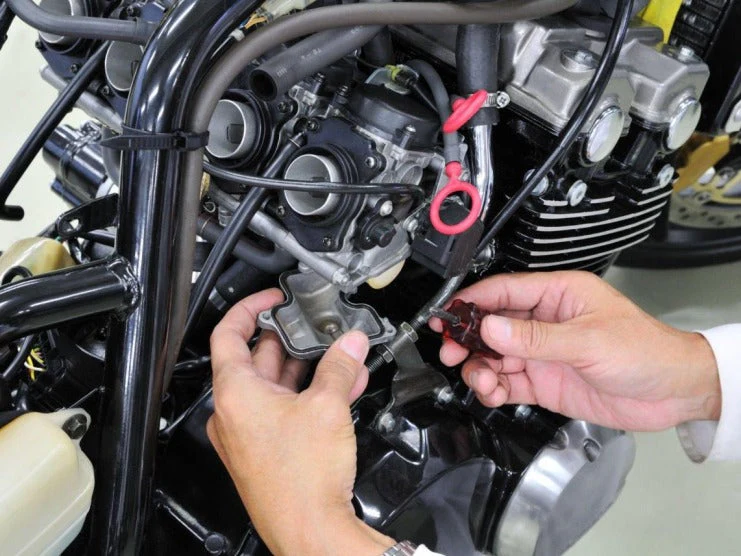Whether you live in a motorhome full-time or use it to vacation in the wilderness with friends and family, it can make for quite an adventure. Motorhomes have changed the way people travel, explore, and camp. From driving on well-paved tarmac roads, exploring scenic RV sites, trying out new recreational activities, to cooking meals on the go, motorhome owners live life on the edge.
While nobody can deny the benefits of a motorhome, most touring motorcycles enthusiasts feel that they miss out on motorcycling due to motorhomes and choosing between the two vehicles is often difficult. Travelers want to combine the grandeur of a motorhome and the fun of riding a two-wheeler. Though riders can buy or build a motorcycle camper trailer to enjoy comfort and riding at the same time, campers cannot match the facilities and comfort of a motorhome.
Fortunately, you can combine the luxury of an RV and the freedom of a two-wheeler by carrying your motorcycle on your motorhome. RV owners frequently carry lightweight kayaks and mountain bikes, with both modes of transportation weighing less than 50 lbs. However, a standard motorcycle weighs between 100-500 lbs. Hence, loading and transporting a motorcycle on an RV can be challenging and is subject to your motorhome’s towing capacity and weight limit.
Also Read: How to Build a Motorcycle Camper Trailer
Table of Content
1. What is a Motorhome?
Motorhomes are luxury vehicles also referred to as recreational vehicles (RV). However, motorhomes are one of the four types of recreational vehicles and feature the following amenities depending on the model:
- Bedding for 2-8 people.
- Kitchen with a stove, refrigerator, oven, microwave, and sink.
- Water tank in the storage area
- A washroom with a toilet and shower
- Furnished Living and Dining Area
- Garage
- Air-conditioning & heating facility
2. Why Carry a Motorcycle on a Motorhome?
Besides your passion for motorcycles, there are several reasons why you should carry a motorcycle on a motorhome:
2.1 Can Participate in Events
When traveling to other cities or states via a motorhome, you might stumble upon an exciting motorcycle event nearby. For example, if you are traveling to the Black Hills in South Dakota during the first 10 days of August, then you can participate in the Sturgis Motorcycle Rally. Other motorcycle events take place year-round in different parts of the United States. At these events, you meet new people from different backgrounds, enjoy amazing music and food, ride America’s most scenic rides, and explore a different biker culture. Having only a motorhome will cause you to miss out on these opportunities. Because motorhomes remain restricted to parking spots and RV sites.
2.2 Explore Scenic Routes Around Campsites
When going camping in a motorhome or boondocking at designated campsites, national parks, and national forests, you are restricted to the parking lot and RV hook-ups. But if you bring a motorcycle on your motorhome, you can ride on scenic roads near the campsites. Visit nearby campsites, landmarks, and tourist attractions. With your motorhome parked safely, you can explore new locations while riding your motorcycle and camping in a tent if you need to rest or enhance your camping experience.
2.3 Getting Supplies from Remote Areas
If you run out of groceries and water during a camping trip, it helps to have quick and reliable transport in case you need to head to the nearest stores. On the other hand, if you want to visit and try the food at local roadside diners, a motorcycle can help you get to such food establishments faster. In these situations, a motorcycle comes in handy since it allows you to visit nearby towns to buy what you need.
2.4 Explore the City
When traveling on the highways, you might want to visit a city for its famous shopping malls, fancy restaurants, museums, beaches, tourist attractions, or movie theaters. Driving a motorhome in the city can be challenging due to the narrow streets and heavy traffic. A motorcycle will make it easier to maneuver through traffic and get to destinations in less time. Also, motorcycles provide an opportunity to enjoy weather and urban scenery with no roofs or doors to
2.5 Reduces Riding Time
Riding long distances requires a certain level of stamina. Some motorcyclists can easily travel 600-700 miles round trip on a motorcycle, while others can hardly ride 200 miles. Certain health conditions and age can also make it difficult to ride for long hours. But if you want to ride a motorcycle on a particular road or in your favorite city, you can carry your bike there using a motorhome.
2.6 Enjoy Recreation
Another recreational activity you can engage in during a motorhome road trip if you bring a dirt bike or a dual sport motorcycle is explore off-road trails. Most national forests, national parks, and state parks allow off-road riding in designated areas. Some states have famous off-road trails, such as the Mojave Road in California, Dumont Sand Dunes in California, Ozark National Forest in Arkansas, and Moab Sandstone Hill Trials in Utah. Riding dirt bikes will improve your riding experience, hone your riding skills, and make your trip more enjoyable.
Hiking trails and lakes or rivers where you can swim, kayak, and fish cannot be accessed by a motorhome. However, they can be accessed by walking or riding a motorcycle. Also, riding a motorbike can help you save energy necessary to participate in recreational activities.
3. Ways to Carry a Motorcycle on a Motorhome
Two ways you can transport a motorcycle on a motorhome are loading it inside the motorhome or pulling it behind on a motorcycle trailer.
3.1 Fitting the Motorcycle Inside a Motorhome
Toy hauler motorhomes and Class A and B RVs have adequate space to load and carry the bike. Some also feature a separate 10-foot or larger storage space. These toy hauler motorhomes have cargo capacities between 6,000 lbs to 12,000 lbs. If your motorhome has enough storage space and cargo capacity to carry your motorcycle, load your ride inside to keep it safe from the elements.
Steps
- Open the garage door and clear the space inside.
- To fit the bike through the narrow garage opening, remove the front mirrors of the bike and lower the height of the handlebars. If your garage is wide enough, skip this step.
- Take a lightweight foldable ramp and place one end on the ground and the other end at the bottom of the garage entrance.
- Use a velcro loop to lock the brake. Pull the brake lever towards the handles and tie the velcro loops on both sides. This will help keep the handlebars in place and prevent the bike from falling over.
- Put the bike on the ramp and push it up into the garage. At the garage entrance, turn the handlebars at an angle to ensure they do not get caught on the edges. It is recommended that you use a ramp with raised sides to keep the tires in place and keep your motorbike from falling off the ramp.
- Once your bike is inside the garage, use 4-6 heavy-duty straps to secure the bike in place. Do not skip this step or you run the risk of denting the garage walls and damaging your bike.
3.2 Haul a Motorcycle Trailer Behind the Motorhome
Hitching a motorcycle trailer at the back of the motorhome is another way you can bring your bike. This method is more difficult but the right hitch system will ensure your motorbike’s weight does not exceed the carrying capacity of the motorhome. Check towing instructions on the owner’s manual before buying and attaching a hitch system.
Steps
- Install a tow hitch at the rear end of the motorhome. The hitch system consists of a reinforced receiver that can fit a draw bar of a specific size. Both reinforced receiver and draw bar are rated based on how much weight they can support. Make sure that the hitch system is compatible with the towing capabilities of your motorhome. If your motorcycle exceeds the carrying capacity of your recreational vehicle and hitch system, then use a different means of transportation. It is worth mentioning that the right hitch system can be used to mount a motorcycle or cargo carrier instead.
- Once you have the right hitch system, slide it under the motorhome from the back then attach it to the mounting points.
- Most motorhomes have enough space to support a hitch system, so you do not need to drill holes or modify the vehicl
- If the mounting points are covered with bolts, replace them with new bolts included with the hitch system. If the tow package does not include bolts and you have to buy them from the hardware store, make sure you buy the correctly graded bolts compatible with the hitch system’s weight capacity.
- Once you locate the threaded holes in the motorhome’s frame, clean them of rust and grime before installing the hitch system. Use a low-viscosity penetrating oil spray and a wire brush.
- Test the holes by inserting and fastening the bolts provided with the hitch system. If there is no friction when inserting the bolts, then mount the hitch.
- Raise the hitch up to the threaded holes, slide the washers on the bolts, fasten the center bolt in the hole first, and then fasten the bolts on the sides. Tighten the bolts using a ratchet and socket to ensure the hitch is securely fastened to the motorhome’s frame.
- Finish installing the hitch system by making sure the bolts are tightened with the amount of torque specified in the instructions provided in the hitch system installation manual.
- Next, install the hitch ball, draw bar, hitch pin, and retainer. Select the right ball size necessary to pull a motorcycle trailer behind your motorhome. The trailer should be level with the hitch system.
- Remove the lock washer from the towing ball by taking off the lock nut. Slide the threaded end of the hitch ball through the top of the ball mount. Cover the ball with a thick cloth to avoid damaging it as you install it on the mount. Place the hitch ball wrench on the lock nut and the pipe wrench to hold the ball in place. Tighten the bolt until the lock washer and nut are fully tightened to the appropriate torque stated in the installation manual. Do not apply too much torque to the hitch or it may break or fail to provide adequate clamping force. If the hitch ball of the hitch system is already installed on the ball mount, skip this step.
- Insert the ball mount into the receiver on the hitch system and align the holes in the hitch and ball mount before inserting the pin.
- Slide the pin through the holes on the hitch and ball mount, then insert the retaining clip through the hole in the pin.
- Place the carrier on the hitch, then insert the cotter pin to keep the carrier in place. Then place the hitch stabilizer to keep the carrier from rattling. Tighten the stabilizer with a ratchet to prevent vibrations that might loosen the carrier.
- Place the ramp on the carrier or trailer to load the motorcycle. Push the bike on the ramp and secure the bike to the rack or trailer using 4-6 mounting straps. Compress the suspensions and tie the brake levers, cables, and throttle using heavy-duty zip ties.
4. Tips to Carry Your Motorcycle on a Motorhome
Many motorhome owners tend to make mistakes that can either damage their recreational vehicles or their motorcycles. Here are a few things to avoid when carrying a motorcycle on a motorhome:
- Most motorhomes have a large space reserved as a lounge and sleeping area. When you fold the beds, you should have enough room to fit a motorcycle. When traveling solo or with a single partner, this space can be used to carry a motorcycle. However, don’t park the two-wheeler inside as it can tip over and damage the floor and furniture. Instead, use a ramp to load the motorcycle and secure it with heavy-duty straps to keep the bike from moving. If your motorhome does not have built-in mounting points to tie the mounting straps around, buy tie-down tracks able to support your motorcycle’s weight from a hardware store. Also, compress the shock absorbers and wrap a zip tie or velcro loop around the brake lever. Be careful not to exceed your motorhome’s load capacity. If your motorhome can carry a 150 lb bike and you load a 350 lb motorcycle, it will strain the engine, wear the tires sooner, consume more fuel, and may also suffer a major breakdown.
- Rent a trailer from U-Haul to transport your motorcycle. U-Haul staff will help you select the best trailer suited for your motorcycle and towing vehicle, hitch the trailer, and load your motorcycle on it.
- If you are using a carrier or trailer to carry your motorcycle, make sure you check their weight capacity and the carrying capacity of your towing vehicle. Exceeding the weight and carrying limits will put a strain on the motorhome’s engine, increase brake and frame wear, damage the tires, and could cause engine failure. All of these factors can increase the risk of accidents.
5. Takeaway
Carrying a motorcycle on a motorhome has many benefits, including providing a secure means of loading and carrying your vehicle. Knowing the weight and carrying capacities of your motorhome will help you enjoy a safe road trip. If you are not confident about loading or hitching a motorcycle to a motorhome, seek professional help. Though expensive, trailer facilities help you tow your motorcycle on long-distance journeys safely. Most services allow you to rent the trailer for a round trip at discounted rates.
If you do not want to carry your motorcycle with you but still want to ride a motorbike, then consider renting one from the local area. Several affordable motorcycle rentals are readily available at various motorcycle rental services. But motorcycle rentals at popular tourist destinations are quite expensive.
Make sure to take all the necessary safety measures when on the road to avoid getting in trouble with the law, and damaging your own and other people’s property.













Leave a comment
All comments are moderated before being published.
This site is protected by hCaptcha and the hCaptcha Privacy Policy and Terms of Service apply.